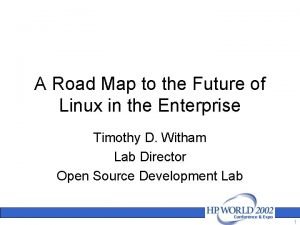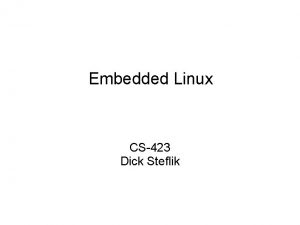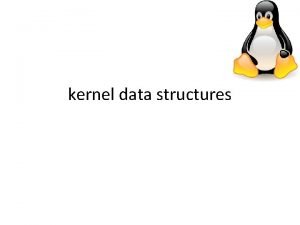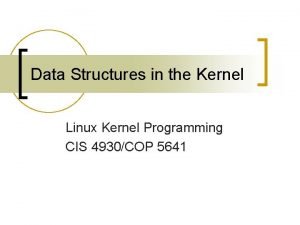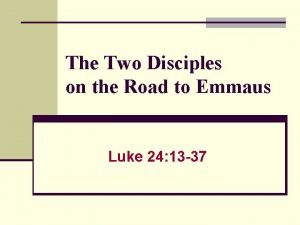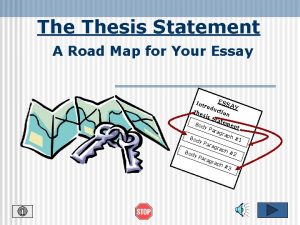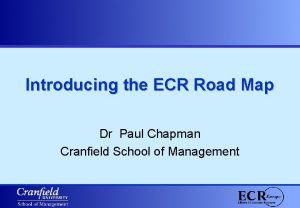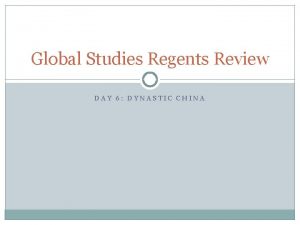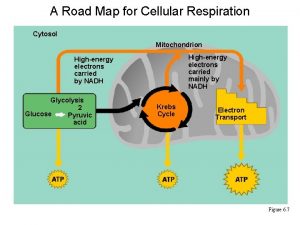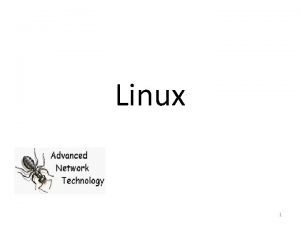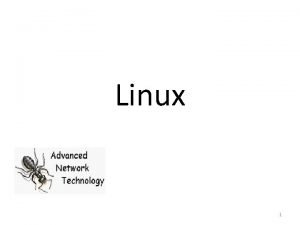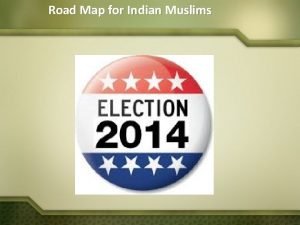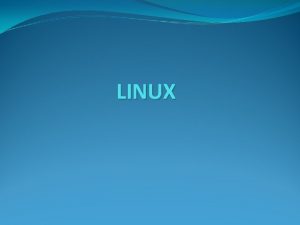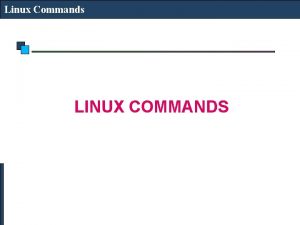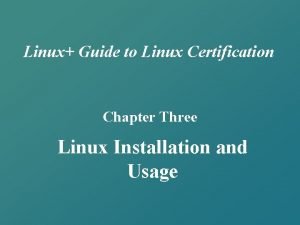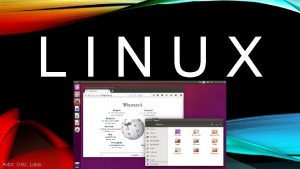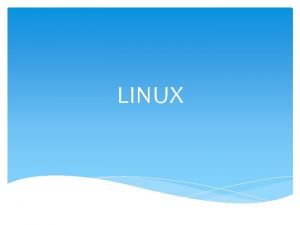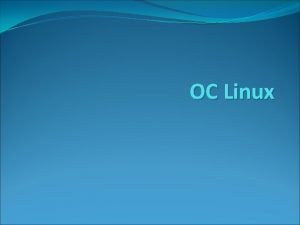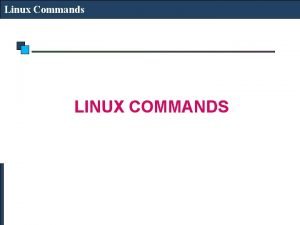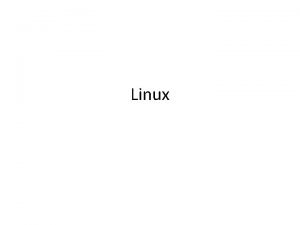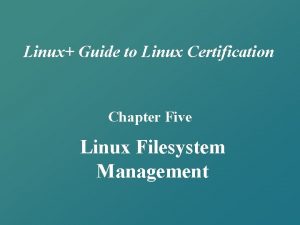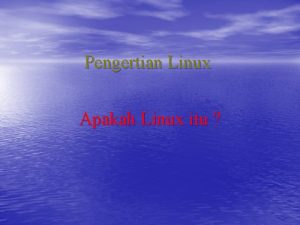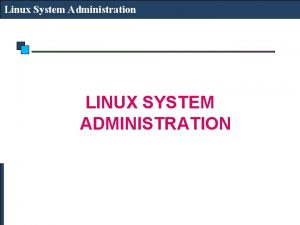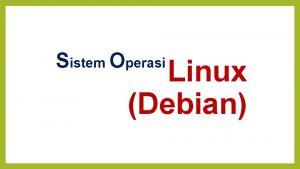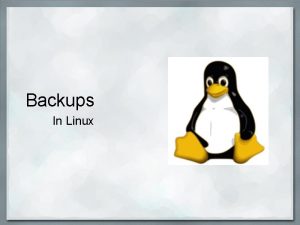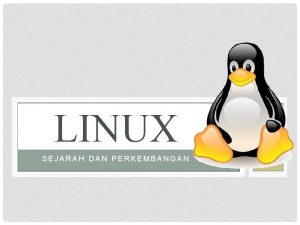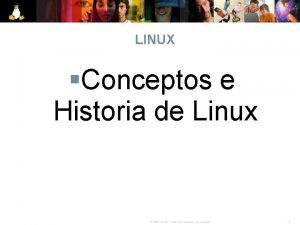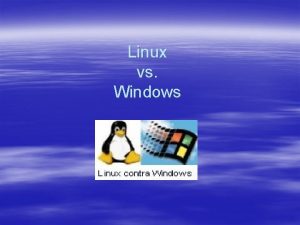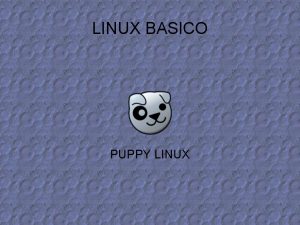A Road Map to the Future of Linux



























- Slides: 27

A Road Map to the Future of Linux in the Enterprise Timothy D. Witham Lab Director Open Source Development Lab 1

Agenda • • • Introduction Why Linux Current Linux Uses Roadmap for the Future Process 2

Open Source Development Lab™ Providing Open Source developers with resources and guidance to build data center and carrier grade enhancements into Linux and its Open Source software stack, enabling it to become the leading UNIXlike Operating System for e-Business deployment and development 3

OSDL Sponsors • Alcatel • Caldera • Computer Associates • Cisco • Dell • Fujitsu • Hitachi • HP • IBM • Intel • Linuxcare • Miracle Linux • Mitsubishi Electric • Monta. Vista • NEC • Nokia • Red Hat • Su. SE • Toshiba • VA Software 4

Open Source Development Lab™ Guidance and resources to enable Open Source development of enterprise and telco capability for Linux Industry Sponsors OSDL Expertise & $$ Expertise + People Internet Data Center Linux for the Enterprise Carrier Grade Linux for Communications Architects & Linux Community Coordinators 5

OSDL is Not. . . • A Distribution vendor • We work with the distributions • Our work benefits the distributions • An ISV • We produce software, but not software products 6

Agenda • • • Introduction Why Linux Current Linux Uses Roadmap for the Future Process 7

Enterprise Linux Motivation • Open standards reduce development cost and risk • Linux* is the fastest growing general purpose server operating system • Most data centers are familiar with UNIX* • And… for most users and developers, Linux and UNIX are interchangeable 8

Data Center Needs • A true uniform operating environment – One common operating system base – One set of development and administrative skills – A common development environment – A common deployment environment – A choice of platforms and platform vendors • Including hardware you already have 9

Linux = Business Control • Open Source Linux* – Returns business control to the IT shop – Ensures compatibility with UNIX systems – Enables customization to meet unique requirements • Choice of hardware and software – Enable use of low cost, high volume servers – Workstations and servers on a common OS • Well-known development environment – Large pool of developers 10

Agenda • • • Introduction Why Linux Current Linux Uses Roadmap for the Future Process 11

Linux* in the Enterprise Clients Internet Intranet Front-end Mid-tier Back-end Application Integration Database Infrastructure Web Server Load Balancing Smart Caching Today OLTP Apps Integration Database Fast I/O Telco 2003 12

Linux Acceptance Today • Linux is a leading OS for web services • Linux is penetrating the mid-tier • Linux needs enhancement to fully meet back end data center requirements 13

Agenda • • • Introduction Why Linux Current Linux Uses Roadmap for the Future Process 14

Developing the Roadmap • • • Identify target industry segments Determine user requirements Establish architecture Develop and publish roadmap (features, timeline) Develop Data Center Linux Specification Identify projects needed to support roadmap – Initiate or support projects as needed • Define compliance with specification – Create validation suite – Create reference implementation(s) • Distributors release DCL compliant Linux 15

Industry Segments • Financial Services is the first target – Aggressive new technology adopters • Leading edge firms already committed to Linux • Understand that IT is a business advantage – High risk, large scale workloads • Large capacity required • Direct opportunity loss if down 16

Financial Services Workload • High end, large scale OLTP – Large I/O, both disk and network – Many CPUs – Large memory (big database caches) • Time critical by nature • OLTP brings strict reliability, availability, and manageability • RASUM requirements 17

Example Requirements • • • Manageable Clustering IO and File System Enhancements Data base optimized virtual memory New IO Architectures (Infini. Band*) Fine Grain Locking RDBMS Performance Optimization Fail Fast, Fail Correct, Fast Boot 16+ Way SMP Enhanced and hardened drivers … OSDL will support or establish projects to meet these requirements 18

Example Projects • Cluster membership API – Clustering infrastructure – http: //osdlcluster. sourceforge. net • Logical volume manager improvements – Clustering – Shared Storage • Scaling algorithms – Linux Scalability Effort – http: //lse. sourceforge. net • Hardened driver specification – developer. osdl. org/architecture • Database workloads for testing – www. osdl. org/projects/performance – OSDL-DBT-1 (TPC-W based) – OSDL-DBT-2 (based on TPC-C) 19

Agenda • • • Introduction Why Linux Current Linux Uses Roadmap for the Future Process 20

OSDL’s Role • The process surrounding Data Center Linux – Organization, structure, support, and advocacy. • Dedicated to getting Linux into the data center by leading its enhancement. – Organizing feature roadmaps with our members, key IT organizations and community developers – Providing the means to accomplish the feature roadmaps – Support and provide resources for open source projects 21

Data Center Linux Working Group An active working forum of industry leaders to support and accelerate the development of Linux functionality for mission critical data center applications for targeted market segments Members • Computer Associates • Fujitsu • Hitachi • • HP IBM Intel Linuxcare • Miracle Linux • NEC • Red Hat 22

Working Group Structure Ap p ro va l Steering Committee Technical Board Roadmap Coordinator (Employee of OSDL™) Marketing Board OSDL Mktg Mgr + OSDL Member Rep. Committee and board members must either: • Represent an OSDL member company • Represent an OSDL affiliated organization directly involved with the technology • Be an OSDL employee Chairperson must represent an OSDL member company • Team members must either: • Represent an OSDL member company • Represent an OSDL affiliated organization directly involved with the technology • Be an OSDL employee • Act as an individual with no employer recognition • Technical Sub-Group 23

Important Dates Publish Tech Scope White Paper August 2002 Release Requirements Definition August 2002 Release Architecture Specification October 2002 Publish Roadmap November 2002 Establish validation process 1 st Quarter 2003 First DCL compliant distribution 2 nd Quarter 2003 24

Summary • Why Linux – Business Control • Current Linux Uses – Widely accepted for many applications • Roadmap for the Future – Data center enhancements are being identified • Process – OSDL is the process – You can contribute 25

How to find out more • Visit the OSDL site: http: //www. osdl. org • Look at the Data Center Linux page – www. osdl. org/projects/dcl – It has contact information, mailing lists, and how to get involved. • Getting Involved – Technical sub-groups • Sign up for the mailing lists – OSDL Sponsorship • Contact Tim Witham (wookie@osdl. org) or Doug Kolb (doug@osdl. org) 26

27
 Future of linux
Future of linux Future perfect and future continuous exercises with answers
Future perfect and future continuous exercises with answers Future simple continuous perfect
Future simple continuous perfect General security
General security Guilots
Guilots What is paved and unpaved road
What is paved and unpaved road Linux kernel data structures
Linux kernel data structures Linux kernel memory map
Linux kernel memory map Linux kernel map data structure
Linux kernel map data structure Future perfect
Future perfect Simple present tense simple past tense simple future tense
Simple present tense simple past tense simple future tense Future continuous future perfect exercises
Future continuous future perfect exercises Future nurse future midwife e learning
Future nurse future midwife e learning Present future continuous
Present future continuous Plan in present progressive
Plan in present progressive Summary tenses
Summary tenses Future plans and finished future actions
Future plans and finished future actions Future perfect tense
Future perfect tense Nulti kondicional
Nulti kondicional Road to emmaus map
Road to emmaus map What is a roadmap in an essay
What is a roadmap in an essay Thesis paragraph
Thesis paragraph Thesis statement and road map
Thesis statement and road map Mol road map
Mol road map Reading road map
Reading road map Dr paul chapman
Dr paul chapman Which phrase correctly describes the tang dynasty?
Which phrase correctly describes the tang dynasty? Road map for cellular respiration
Road map for cellular respiration
